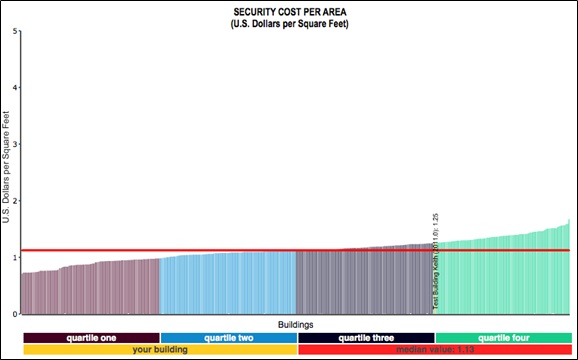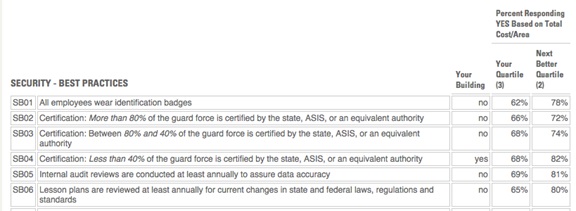In last few months, this column reviewed the implementation of best practices in the areas of maintenance, janitorial, and utilities. Facility Managers often focus on costs without looking carefully at which best practices could or should be implemented to maintain or improve services and reduce costs.
Benchmarking is a very useful tool to help with the process of identifying best practices. By strategically implementing selected best practices you can achieve operational efficiencies that reduce costs or improve services. Despite all this data to support good decision making, many FMs feel like they are left with just one option to cut and cut some more. Below, we show how benchmarking security costs and best practices can work to your advantage.
- Benchmark the costs of your security services.
- Normalize the data so you can compare your costs to others by the area of the building and the headcount.
- Look at the best practices that have been implemented by your peer group for:
- Your quartile’s cost performance, and
- The next better quartile’s cost performance.
- Implement the best practices that would achieve the highest return or best customer service improvement for your organization.
Let’s consider an organization that is benchmarking its security services. First we need to benchmark the cost component of its services with an appropriate peer group. In the example below, two filters are used:
- Buildings larger than 600,000 GSF, and
- Suburban settings.
In Figure 1, our building is shown in yellow at the end of the third quartile with a cost of $1.25 per gross square foot (GSF). The median for this peer group is shown with the dark horizontal red line at $1.13 per gross square foot. This indicates there is ample room for improvement, but what changes should be made?

Next, let’s look at the first four Security Best Practices from the FM BENCHMARKING application (see Figure 2). If you have not implemented any of these best practices which do you think would have the highest return?

Most security consultants would recommend:
- SB01, where all employees wear their badges all the time in the facility. Note too, that there is a significant increase in the implementation of this best practice (16%) between the first and second quartile. It makes good business sense to implement this as a best practice and it is unlikely that there is any significant cost of implementation; maybe some additional lanyards should be provided if employees can not find the ones that were issued to them. Overall, this will result in tighter control of those in the building and fewer security incidents.
- SB02 – SB04 are ranges of implementation for security certification. Our response is in the lowest range available. Clearly more training and opportunities for certification would result in a more qualified and productive workforce.
- SB05 shows the response rate for internal audit reviews. Internal audits are an excellent opportunity to identify areas for improvement and identify deficiencies. Again, our building does not implement this practice while 81% of those in in the next better performing organization do.
- SB06 shows the response rate of the peer group for annual lesson plan review. Again, this is an excellent opportunity to identify areas for improvement and 80% of those organizations in the next better quartile have implemented this practice.
There are many more Security best practices and this article was only intended to illustrate how to approach the evaluation of which best practices to implement. You should work with your Security manager and possibly a consultant to fully evaluate them.